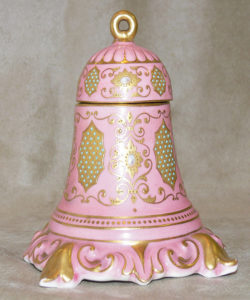
We had no correct answers to our October’s What Is It. The item is an inkwell. Anne Gilbert tells us, “While today’s twitter generation may not even know what an inkwell or inkstand are another generation is seriously collecting them. They have been popular since the 1970s when they were appreciated not just for historical interest but design and beauty. Many are so beautiful they can be classified as an art form while others were simple, utilitarian designs of glass and wood.
Over the centuries they have been made from a variety of materials from fine porcelain, precious metals to wood and seashells. When they come to auction, depending on their maker, age, historical significance and material, prices range from $100 to thousands.
The use of early writing implements date to the beginning of civilization but actual writing wasn’t done by private individuals till the 16th century. A few Italian and Majolica inkstands dating as early as the 1500s have survived. France, Germany and Holland began making inkstands and wells similar to Majolica during the 16th century. They are known as Delft and Delft type.
In the 18th century every desk of the monied class boasted an inkwell and/or inkstand. The materials were varied from sterling silver to the finest example made by important goldsmiths. They were given as gifts on special occasions and as presentation pieces. When they were custom painted and made in China they became known as Chinese Export.
By the end of the 19th century wealthy Americans and Europeans topped their desks with writing sets made by Tiffany or French figural bronzes combined with Baccarat crystal. At the time they came with desk accessories such as letter holders, calendars and blotters.
CLUES: The best ways to identify the age and country of early inkwells and stands is by material, styles and shape. For example, 18th century inkstands were casket shape with an enclosed inkpot. Others were tray form with bullet feet. English silver examples followed the prevailing fashion, such as rococo style with scrolled and reeded rims.
A little remembered custom developed in 18th century America. Silver stands combined with cut glass (later pressed) inkpots came with a tiny bell. This alerted servants that the mail was ready to be sent off.
As in all collecting categories there are reproductions. Beware of English brass stands and wells, Bennington pottery-types and Sandwich glass style wells. There are Arts and Crafts, Art Deco examples and many novelty types such as Black Forest. Discoveries await at garage sales and flea markets. Do some research on the internet and the books on the subject. The golden age is considered from 1870 to 1920 when elaborate designs were made. PHOTO CAPTION: (1) Coalport porcelain inkwell. 19th century. PHOTO CREDIT: (1) Kofskis Auctions. 3155 County Road. Palm Beach, FL















Follow Us